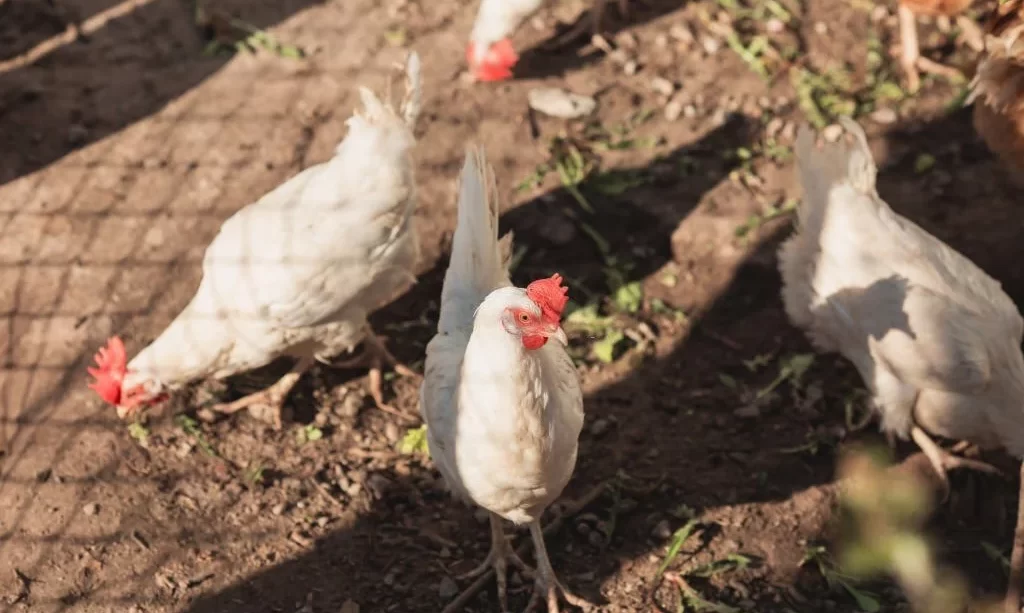As backyard chicken enthusiasts and conscientious poultry keepers, ensuring the well-being of our feathered friends is paramount. Chickens, with their endearing clucks and spirited personalities, depend on us not only for shelter and security but also for their sustenance. A crucial aspect of chicken care revolves around providing a nutritionally balanced diet that caters to their specific dietary needs. In this exploration, we dive into the world of chicken nutrition to answer a common query: Can chickens eat romaine lettuce?
Chicken Dietary Needs
Chickens, whether kept for egg production, meat, or simply as cherished pets, have distinct dietary requirements that dictate their health, vitality, and overall productivity. These avian omnivores require a well-rounded diet that encompasses several essential components:
- Protein: Chickens need protein to support growth, feather production, and egg laying. High-quality protein sources like insects, seeds, and legumes are essential parts of their diet.
- Carbohydrates: Carbohydrates supply energy for daily activities, ranging from scratching the ground for insects to roaming around the coop. Grains like corn and wheat are common carbohydrate sources.
- Vitamins and Minerals: Vitamins and minerals are vital for maintaining a chicken’s health and preventing deficiencies. These micronutrients are typically derived from a diverse range of foods, including fruits, vegetables, and grit.
- Fiber: Fiber aids in digestion and promotes gut health in chickens. It is primarily obtained from plant-based foods such as greens and vegetables.
A well-balanced diet that addresses these nutritional needs is essential to ensure that chickens lead happy, healthy lives. It is within this context that we explore whether romaine lettuce, a popular leafy green, can be a beneficial addition to a chicken’s menu while keeping their dietary requirements in mind.
Romaine Lettuce Overview
Romaine lettuce, often associated with crisp salads and refreshing wraps, is a popular leafy green that has found its place in human cuisine. This versatile lettuce variety, scientifically known as Lactuca sativa var. longifolia, is distinguished by its elongated leaves and mild, slightly sweet flavor. Romaine lettuce is celebrated for its crisp texture, making it a favorite choice for salads, sandwiches, and wraps.
From a nutritional perspective, romaine lettuce offers several advantages. It is a low-calorie vegetable rich in vitamins and minerals, particularly vitamins A and K. Additionally, romaine lettuce provides dietary fiber, which can contribute to digestive health. Its high water content makes it hydrating, making it a popular choice for those seeking refreshing and nutritious meal options.
- DELICIOUS TRUSTED VARIETY – Popular summer romaine lettuce seed used by gardeners for years. Romaine lettuce is not only packed with flavor, but it is very nutritional.
- CRISP – Like the romaine lettuce you find in the store. Parris island lettuce seeds produce a great head of romaine lettuce.
- SEASONS – Romaine lettuce is great to grow in the spring, summer, fall, and winter gardens. A favorite amongst hydroponic seeds too.
- USA – All of our seeds, including the Parris island cos romaine seeds for planting, are heirloom, open-pollinated and non-GMO, and grown in the USA. Don’t buy inferior seeds from other countries. This should give you added reassurance that not only can you enjoy the seeds this season, but you can save the seeds each year, adding food security to your home.
- PACKETS – Each heirloom lettuce seeds packet is printed on water-resistant paper, in full color, with growing and harvesting directions included. Each heirloom romaine lettuce seeds packet contains at least 2 grams of seeds (approximately 2200+ seeds).
Can Chickens Eat Romaine Lettuce?
The query of whether chickens can partake in the goodness of romaine lettuce is a subject of interest for poultry enthusiasts. As with any potential addition to a chicken’s diet, there are considerations to ponder.
Romaine lettuce, when offered to chickens in moderation and appropriate portions, can indeed be a suitable dietary choice. Its crispness and mild flavor often appeal to chickens, making it an enticing treat. Moreover, romaine lettuce contains valuable nutrients that can complement a chicken’s overall nutrition, including vitamins and hydration.
However, it’s crucial to strike a balance. While romaine lettuce can be a nutritious addition, excessive consumption can lead to imbalances in a chicken’s diet. Additionally, certain precautions must be taken, including washing the lettuce thoroughly to remove pesticides and contaminants and cutting it into manageable pieces to prevent choking hazards.
In the following sections, we’ll delve deeper into the benefits of feeding romaine lettuce to chickens, potential risks to be aware of, and guidelines for responsible feeding practices to ensure the health and happiness of your feathered companions.
Risks and Precautions
Feeding romaine lettuce to chickens is not without its considerations and potential risks. As conscientious chicken keepers, it’s essential to be aware of these factors:
- Choking Hazard: Chickens can sometimes be overzealous when consuming leafy greens like romaine lettuce. To mitigate the risk of choking, it’s advisable to chop or tear the lettuce into smaller, more manageable pieces before offering it to your flock.
- Imbalanced Diet: While romaine lettuce provides valuable vitamins and hydration, it should be viewed as a supplement rather than a primary food source. Offering too much lettuce at the expense of other essential components of their diet can lead to imbalances and nutritional deficiencies. Ensure that romaine lettuce is just one element of their diverse diet.
- Pesticide Residues: If you source romaine lettuce from commercial sources, it’s important to be mindful of pesticide residues. Thoroughly washing the lettuce can help reduce pesticide exposure. An even safer option is to provide organic romaine lettuce when available.
- Digestive Upset: Chickens have sensitive digestive systems. Introducing new foods, including romaine lettuce, should be done gradually and in moderation. Excessive consumption of unfamiliar foods can lead to digestive upset.
How to Feed Romaine Lettuce to Your Chickens
To offer romaine lettuce to your chickens in a safe and enjoyable manner, consider these guidelines:
- Wash Thoroughly: Wash romaine lettuce leaves under running water to remove any dirt, pesticides, or contaminants. Ensure the lettuce is clean before feeding.
- Prepare Appropriately: Cut or tear the romaine lettuce into smaller, bite-sized pieces. This minimizes the risk of choking and makes it easier for chickens to consume.
- Moderation is Key: Romaine lettuce should be treated as a treat or supplement rather than a staple in their diet. Offer it in moderation, alongside their regular feed.
- Monitor for Digestive Issues: After introducing romaine lettuce, keep an eye on your chickens for any signs of digestive discomfort, such as diarrhea. If issues arise, reduce or eliminate the lettuce from their diet.
By following these precautions and offering romaine lettuce responsibly, you can provide your chickens with a nutritious and enticing treat while maintaining their overall health and well-being. In the subsequent section, we explore other safe and beneficial foods that can complement a chicken’s diet.
Other Safe Foods for Chickens
In addition to romaine lettuce, there is a plethora of safe and nutritious foods that you can incorporate into your chicken’s diet to enhance their overall nutrition and keep them engaged and content. Here are some chicken-friendly options:
- Leafy Greens: Apart from romaine lettuce, chickens enjoy a variety of leafy greens like spinach, kale, Swiss chard, and collard greens. These greens are rich in vitamins and provide a welcomed change in their diet.
- Fruits: Many fruits are suitable for chickens, including apples, pears, berries, and melons. Be sure to remove any seeds or pits and offer fruits in moderation due to their natural sugars.
- Grains: Chickens thrive on grains like corn, oats, barley, and wheat. These grains can be offered as part of their regular feed or as scattered treats for mental stimulation.
- Protein Sources: Insects such as mealworms, crickets, and earthworms are excellent sources of protein for chickens. They satisfy their natural foraging instincts and provide essential nutrients.
- Vegetable Scraps: Leftover vegetable scraps from your kitchen, like carrot tops, cucumber ends, or broccoli stalks, can be shared with your chickens, reducing food waste.
- Herbs: Chickens appreciate herbs like parsley, basil, and oregano. These not only add flavor but can have potential health benefits.
- Boosts Growth and Vitality – Packed with 16% protein from organic grains, this feed promotes rapid muscle growth, strong bones, and fluffy, vibrant feathers for your chickens and ducks, ensuring a thriving flock.
- Pure Organic Nutrition – Give your flock a healthier choice with our premium feed, made from a formula with no unnecessary additives, delivering clean, wholesome nutrition for your laying chickens and ducks.
- Versatile Feeding Options – Choose what’s best! Feed dry for easy, mess-free meals or choose fermented to prevent picky eaters from selecting only their favorites. Both methods provide balanced nutrition, keeping every bird healthy and satisfied.
- Eco-Friendly Packaging – Comes in recyclable and compostable packaging, making it a simple, sustainable choice for your flock and the planet. Enjoy quality feed while reducing waste and supporting eco-friendly farming practices.
- Grown and Milled in North America – Our feed is proudly sourced and milled in the USA and Canada. Choosing our feed means investing in local businesses and sustainable agriculture.
Conclusion
In the quest to provide optimal care for your chickens, the inclusion of romaine lettuce in their diet can be a nutritious and enjoyable choice, provided it is done in moderation and with attention to potential risks. Chickens are omnivores with diverse tastes, and their diet can be enriched with a variety of safe foods that contribute to their overall well-being.
As conscientious chicken keepers, it’s essential to strike a balance, ensuring that treats like romaine lettuce complement their primary diet rather than overshadow it. By following best practices, monitoring their health, and offering a mix of nutritious options, you can ensure that your feathered companions lead healthy, happy lives. Remember, a well-fed and contented chicken flock is more likely to reward you with fresh eggs and joyful clucks in your backyard coop.






